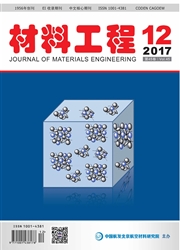

 中文摘要:
中文摘要:
研究了冷拉拔铜包铝细丝合理的退火工艺及其对材料力学性能、铜包覆层组织及界面扩散层厚度的影响规律。结果表明:铜包铝细丝的最佳退火工艺为300℃×60min。低于200℃退火时,铜包铝细丝铜包覆层处于回复阶段,细丝强度从冷拉态的361MPa急剧下降到236MPa,延伸率略有降低;300℃退火后,铜包覆层的再结晶完成,细丝的抗拉强度下降至约152MPa,延伸率升到最高,达到16.3%;400℃退火后,铜包覆层晶粒显著长大,界面处生成脆性金属间化合物,延伸率急剧下降。界面扩散层的厚度随退火温度和保温时间的增加而增大,当退火温度低于300℃时,扩散层厚度随退火时间增加缓慢;当退火温度高于350℃后,扩散层厚度快速增大。延伸率随扩散层厚度的增加先升高后降低,当界面扩散层厚度为2μm时,铜包铝细丝的延伸率最高。
 英文摘要:
英文摘要:
The appropriate annealing process for cold-drawing copper cladding aluminum wire was studied. The variations of mechanical properties, microstructure of copper sheaths and diffusion thickness of copper cladding aluminum wires with annealing process were investigated. The results show that the proper annealing process for copper cladding aluminum wire is 300℃×60min. At an annealing temperature below 200℃, a recovery of microstructure occurs in copper sheaths, the strength of the copper cladding aluminum wire decreases dramatically from 361MPa to 236MPa and the elongation drops a little compared with unannealed wires. Annealed at 300℃, the recrystallization of microstructure in copper sheath is fully completed, the strength of the copper cladding aluminum wire drops to 152MPa and the elongation achieves maximum value 16.3%. The grain size of copper sheath grows up and intermetallic phases are formed at interface as annealing temperature reaches 400℃, while the elongation of material decreases. The diffusion thickness increases as annealing temperature and time increase. When the annealing temperature is lower than 300℃, with the increase of annealing time, diffusion thickness increases slowly. When the annealing temperature is higher than 350℃, the diffusion thickness increases quickly as the annealing time prolongs. With the diffusion thickness increasing, the elongation shows a trend that it increases at the beginning and then decreases. The critical diffusion thickness of copper cladding aluminum wire is 2μm, when the material possesses optimum mechanical properties.
 同期刊论文项目
同期刊论文项目
 同项目期刊论文
同项目期刊论文
 A fractal-based model for the microstructure evolution of the silicon bronze wires fabricated by die
A fractal-based model for the microstructure evolution of the silicon bronze wires fabricated by die 期刊信息
期刊信息
